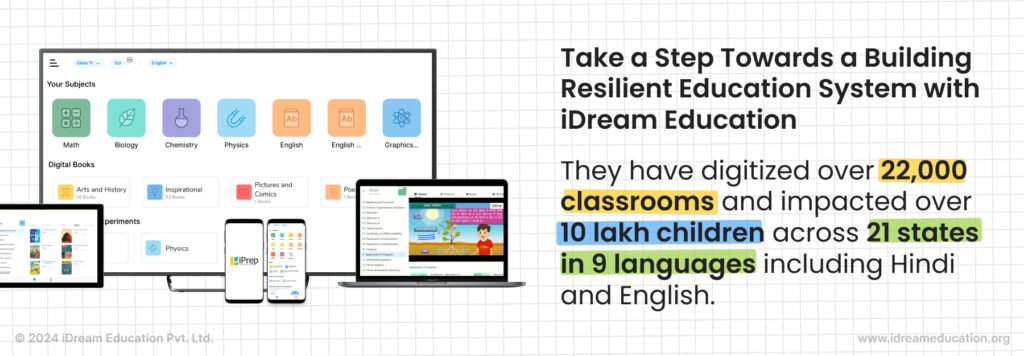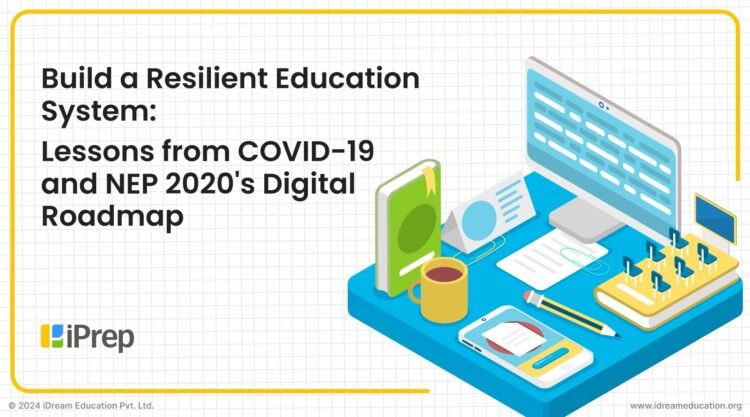The COVID-19 pandemic was a wake-up call for India’s education system. School closures highlighted a glaring digital divide, leaving many students, especially in remote areas, unable to continue their learning. This crisis underscored the urgent need for a strong e-learning infrastructure capable of reaching last mile learners. An infrastructure that enables accessibility, flexibility, scalability and is adoptable.
Drawing from the COVID-19 lessons, National Education Policy (NEP) 2020 is put together
This policy envisions a “digital India” where quality education is accessible to all, regardless of location or circumstance. The NEP prioritizes online learning platforms, digital literacy, and infrastructure development, and how these efforts can enhance India’s education landscape. The National Education Policy emphasis on technology for flexible learning proposing availability of online and classroom courses. Blended learning tools such as Learning Management Systems (LMS for schools) play a crucial role in realizing this vision. This is because LMS becomes a central hub to access learning resources and track progress, fostering an inclusive and engaging environment that caters to diverse needs.
Vishal Goswamy- Associate Director – Marketing and Growth at iDream Education shares his insights on how a NEP-aligned Learning Management System can contribute to building a resilient education system
Their work with government school students and teachers provides valuable insights on the needs of the education ecosystem. At the same time, National Education Policy (NEP) establishes critical principles aimed at ensuring quality education for all. Based on iDream Education’s experiences and the foundational aspects of the NEP, there are several key points that the social sector should ensure when planning school education programs.
Leveraging LMS with Multi-Device Compatibility
By enabling a Learning Management System that is compatible with diverse operating systems and devices, there is a clear scope of democratizing access to e-learning infrastructure and educational content. Many rural households own at least one smartphone, an LMS that is easily installed across different OS and devices can ensure broader access to digital learning. iDream Education, have built an LMS that is compatible with all hardware including existing school infrastructure such as projectors and computers (classrooms and labs) optimizes resource utilization, promoting efficiency and cost-effectiveness. Their innovation is not only facilitating uninterrupted learning during unforeseen disruptions but also fosters a culture of digital inclusivity and resourcefulness, key tenets required to build a resilient education system as per NEP 2020. Teachers and students are no longer restricted to the classroom, learning goes beyond to homes and so does teacher-student connect.
Structured LMS and Content: Fostering Synergy and Engagement
A key pillar of an LMS lies in its ability to enable structured digital content, ensuring synergy across all levels of education (traditional and digital). This requires developing a content library that is meticulously mapped to NCERT and State Board curricula. Such LMS has the capability to foster a textbook aligned learning experience, ensuring synergy. One of the reasons for the adoption and engagement of iPrep by iDream Education without much training is because of its well-organized repository of curriculum multimedia content, structured chapters based on class and subject. This structure of iPrep LMS is catering to diverse learning styles and preferences, and ultimately making learning more accessible and enjoyable for all.
Bilingual Interface and Content: Reaching the Last Mile
Promoting multilingualism, a key focus of NEP 2020, is vital in building a resilient education system. By offering not only digital content but also a user interface in local languages, an LMS empowers social sector organizations to effectively reach and engage last-mile learners. Providing educational materials in familiar languages fosters a sense of inclusivity and belonging, making every student feel welcomed and valued within the education ecosystem. iDream Education has worked with many students who struggled to continue their learning due to language barriers. Once they gained access to a bilingual platform and content, these students were able to learn independently, grasp concepts more easily, and actively engage in their educational journey.
Multimedia Content: Fostering Conceptual Understanding
Another key challenge in the current education system is the prevalence of rote learning and exam-centric focus, which hampers critical thinking and conceptual understanding among students. An iPrep LMS addresses this by providing an organized library of multimedia educational content, categorized by class, subject, chapter, and topic. The diverse range of resources could include animated video lessons, syllabus books, practice exercises, simulations, practicals and more. This structured and multimodal approach encourages a shift from rote learning to a deeper conceptual understanding, in line with the NEP 2020’s vision.
Personalized Learning Paths: Recognizing and Fostering Unique Capabilities
Recognizing, identifying, and fostering the unique capabilities of each student is paramount in building a resilient education system, as emphasized in NEP 2020. Many K-12 students experience learning gaps in various subjects, chapters, or topics due to factors such as disengagement, lack of interest, absenteeism, and particularly due to the discontinuity in learning caused by the COVID-19 lockdowns. To address this, an LMS must be adaptive to individual student needs. By offering structured learning paths that allow students to address historical learning gaps at their own pace, without the stigma of being taken to lower-grade levels, the LMS fosters a sense of empowerment and self-paced growth. One of the examples of this is iDream Education’s PAL LMS which is developed with a guided mechanism personalized approach. It ensures that every student is recognized, identified, and nurtured according to their unique capabilities, contributing to a truly inclusive and resilient education system.
Data-Driven Insights: Enabling Continuous Improvement
Efforts mean nothing without results. Implementing digital learning effectively necessitates continuous reporting and monitoring to gauge its impact. An NEP-aligned LMS should therefore prioritize consistent usage tracking, providing detailed insights into how students and teachers interact with digital content on a subject-wise, class-wise, and topic-wise basis. Vishal Goswamy concluded by highlighting that the LMS should have the capability to enable access to project-level dashboards to social sector organizations and other stakeholders. This empowers them to take data-driven decisions to improve outcomes. This further enables stakeholders to identify learning gaps, implement timely interventions, and facilitate regular formative assessments, ultimately maximizing learning outcomes.
Take a Step Towards a Building Resilient Education System

iDream Education has been at the forefront of building a learning management system for schools, aligning it with the fundamental principles of NEP 2020 and the specific needs of school education. As mentioned above by Vishal Goswamy, their LMS is bilingual, adaptive mechanisms, and a vast library of curriculum aligned multi-media content, with reporting capabilities and everything that is required to build a resilient education system. They have digitized over 22,000 classrooms and impacted over 10 lakh children across 21 states in 9 languages including Hindi and English. They work with CSR, Foundations, NGOs and in some states directly with the state government to make quality education accessible to all.
If you’re interested in learning more about iDream Education’s intuitive Learning Management System for schools and how you can enable it in your education program, please share your details here.





